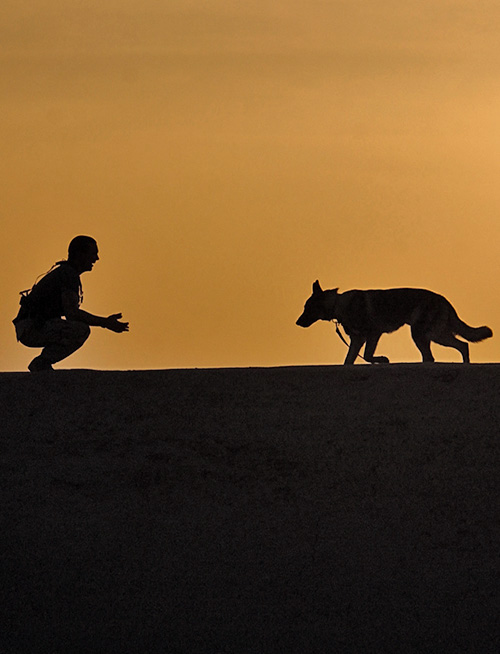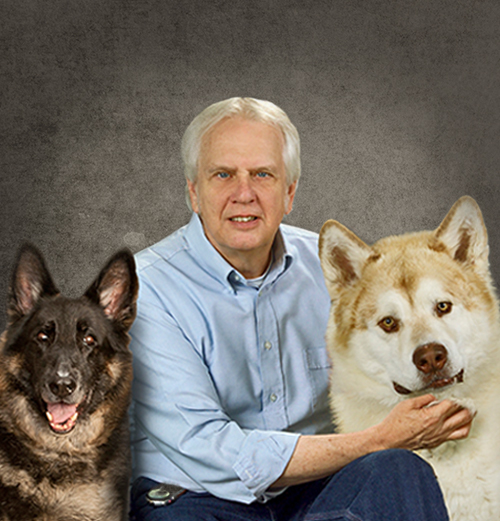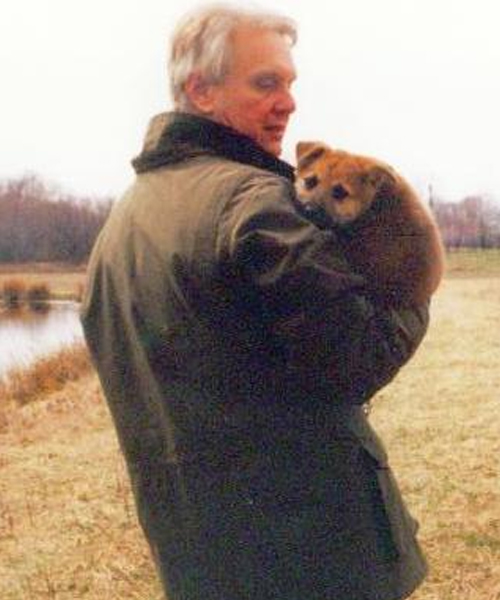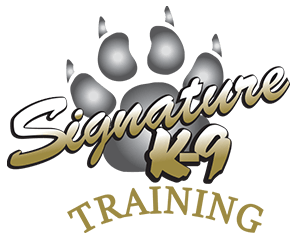
Signature K-9 Behavior & Training
Many well meaning people advertise themselves as dog trainers. Of those, some are members of training clubs. In those clubs, a trainer may come from the ranks of the club membership and their credential for training may rest entirely on the fact that they have earned titles on their personal dogs. Although this is admirable, it does not provide the same foundation for training as a certification program based on a behavior study curriculum; supported by work with hundreds of dogs with different problems; and continually upgraded through an education program based on research.
Training Methods vary widely and behavior researchers have learned much in recent years. Good trainers use a variety of approaches which are based on an understanding of Operant and Classical Conditioning. These techniques are tailored to the personality of the individual dog; the specific problems that exist, and goals of the handler.


Dr. Jim Akenhead, Signature K-9 Training,
Owner and Dog Trainer
Dr. James Akenhead, was issued professional trainer certification under the auspices of The Ohio Board of Proprietary Schools. This Intensive certification program included laboratory experience, classroom lectures, guest speakers, field visits (i.e. Guide Dogs for the Blind) written and oral examinations, and evaluation of training methods using both video tape and instructor observation. The curriculum also included advanced obedience, assistance dog training, tracking, and protection training.
Dr. Akenhead is also certified as an Animal Behavior Consultant, Canine Division, under the auspices of the international Association of Animal Behavior Consultants. This organization has divisions which specialize in most pet animals.
These certification programs focus on topics such as: Ethics, organization, legal issues of training, client relations, kennel and training facility operations, health and nutrition, breed origin and purpose, evaluation processes, behavior modification and shaping, research and problem solving.
Jim has also been certified by the Certification Council of Professional Dog Trainers. This certification requires passing a 3 hour examination on training and behavior.
In addition to this professional trainer certification, Dr. Akenhead holds 5 earned college degrees including a Doctorate in Education and research and a Masters Degree in Counseling which includes background in psychology and behavior theory.
Jim has taught at the university level: has been recognized as a distinguished graduate of Bowling Green State University: has been included in 7 Who’s Who Directories; and, with his wife Charlene, has been recognized as “business professional” of the year by a local service organization.
For more than 45 years Jim raised and trained German Shepherds. He has owned spaniels, retrievers, terriers, chows, shelties, beagles, and cross breeds of all varieties. He and his wife Charlene, owned Northern Legend Kennel which specialized in Alaskan Malamutes. In 1995, Jim worked with his son Matt to form Signature K-9 Services.
On a national and international level, Dr. Akenhead has served on the Boards of
Directors of the Certification Council for Professional Dog Trainers, the International Association of Animal Behavior Consultants and the National K-9 Trainers organization.

Canine Behavior Workshop: Identification and Redirection of unwanted behavior. Focus on: Behavior analysis, counseling. Used case studies of aggression cases, Dr. John Fisher. Author: Training the Dog in the Human Pack. Also included discussion of rehoming dogs and how to make that decision.
Excel-erated Learning: Overview of learning theory; language, single-event learning (habituation, sensitization and relevance of commands); classical conditioning (associations), operant conditioning (consequences of behavior); Behavior modification techniques (shaping, prompting and fading). Efficiency of learning (deprivation, timing, reinforcement schedules, random vs. differential schedules, contrast effects and conditional reinforces); Also covered stimulus control, (discrimination, overshadowing, blocking context, reinforcer sampling), extinction (spontaneous recovery, extinction bursts, partial reinforcement and flooding), Conditioned emotional responses (fears and phobias, aggression, counter conditioning & desensitization), auto shaping, taste aversion, aversive control of behavior (negative reinforcement, positive punishment, escape/avoidance responding and species specific defense reactions, and vicious-cycle behavior: learned helplessness. Pamela Reid, Ph.D. Author Excel-erated Learning.
The Challenging Canine: Cheryl Smith, Classification and Etiology of aggression. Anticipation and correction of aggressive behavior. Interpretation of dog’s body language. Recognition of stimuli which trigger aggressive responses. Examination of sibling rivalry and multi-dog households. Systematic Desensitization of stimuli which spark dog/human aggression and dog/dog aggression. Seminar and laboratory on fighting & biting, related to dog/dog & dog/human aggression.
Wolf Behavior: As Basis for Canine Behavior: Supervised observation of Wolf Pack behavior at AM, PM, and throughout the day. Application of observation and research records of wolf behavior with relevant discussion during daily instruction sessions. Discussion and available research on Wolf Hybrids; their genetics, training and behavior. Application of understanding of the aforementioned behavior to dogs and dog behavior. Dr. Erich Klinghammer Ph.D., author: Applied Etiology: Basic principles of Etiology and Psychology. Wolf Park, Battleground Indiana. Longest study of wolf behavior in the U S.
Canine Theriogenology: Reproduction & Nutrition: Theriogenology Department, College of Veterinary Medicine, The Ohio State University 601 Tharp Street, Columbus, Ohio.
Legacy’s International Behavior & Training Camp: Terry Ryan (discussion and process leader), author: The Tool Box for Remodeling Your Problem Dog. Topics Included:
Clicker Training: (Operant Conditioning) under supervision of Bob Baily (Zoologist & Director Navy Dolphin Training Program) and Marian Breland-Baily Ph.D. (associate of BF Skinner).
Ted Turner: Demonstrations and lecturer on training of sea animals and birds. Discussion of Sea World’s dog training program.
Turid Rugaas: (Norway). Identification and use of instinctual canine calming signals to rehabilitate shy and fearful dogs. Also, Heeling the Hagan Hundeskile way (appealing to the dogs natural instincts).
Dr. Gaille Perry: (Australia). Veterinarian, teacher and competitor. Lessons on canine first aid techniques (includes heart, pulse, respiration, signs of stress).
Tellington Touch: Debra Potts, T-Team Practitioner (Oregon): Enhancing optimal health, behavior and performance. Hands on practice on how to work with the dogs body to relieve tension and work successfully with unfocused or easily excitable dogs.
John Nussbaum: (Ohio) Exploring drive theory as it applies to Schutzhund. Learning how dogs use their natural drives in functions like protection, tracking, and search.
The Third Way: Seminar on handler and environmental influence on Canine behavior. Focus on trainer as source of reinforcement (rather than force or food luring) Chris Bach, Author, The Third Way.
Animal Communication: Beth Lynch & Janet Shepherd: A look at two-way communication processes with animals. Focus on Behavior, health, the dying process, and problem solving. Uses intuition as a vehicle for communication.
Showing Dogs to Win: Nancy and Eric Liebes. Preparing a dog for behavior in the show ring. Examines movement, training, anticipation and making a plan, preparation, & troubleshooting.
Hip Dysplasia & Other Orthopedic Disorders: Topics included: Controversial aspects of hip Dysplasia, opinions about origin and causes, myths regarding cures and prevention, genetic basis, prevention or lowering of probability. Process included use of X-rays to compare various diagnosis procedures and treatment options, film clips of dogs with and without Dysplasia. Fred Lanting. Author Canine Hip Dysphasia and Other Orthopedic Problems & The Total German Shepherd Dog.
Canine Play & Aggression: Sets context for: Opinion, Controlled Study (peer review), Etiology and Behavior. Discussed Belief and Bias. Topics: Function of play, interpreting play, Inter-Dog Aggression, Fear and Aggression, Assessment, Planning & problem solving. Jean Donaldson, author: The Culture Clash, Dogs are from Neptune, and Mine. Founder: San Francisco SPCA Academy for Dog Trainers.
Advanced Canine Behavior: Patricia McConnell, Author ; The Other End of the Leash. Lectures on relationship of two different species and the ramifications of that association. Built on understanding domestic dog nature: included information from genetics to litter conditions and through training/behavior development. Ohio Veterinary Medial Association.
Tricks of the Trade: Pat Hastings. Topics: Breeding type, temperament, structure, genetics; Puppy Evaluation as related to purpose of breed; Grooming processes; Nutrition and feeding facts. Supplementation for specific needs; Finally, Behavior management.
E-Collar Workshop: With the upsurge in various technological approaches to training and behavior control, this workshop presented information on use of remote collars. Topics included: how to evaluate need for use of electric stimulation devices, how to determine the level of stimulation needed, how to integrate the education or understanding component when using a stimulation device. Seminar leader: Fred Hassen. Explored various remote collars for dogs with special needs.
Dog Behavior and Training: Topics: Understanding application of Operant Conditioning and relationship to Classical Conditioning. Included: impact of genetics and understanding breed intention; breeder behavior and environment, bites, aggression and behavior modification, Establishing baseline behavior and Matrix for training, Topical problems and setting priorities, Managing entire environment as part of training and behavior management Dr. Ian Dunbar, author, Teaching Old Dogs New Tricks (and others).
Throw-Away-Dogs: A discussion of why dogs are abandoned. Topics Included reasons given for discarding dogs; methods for obtaining history, typical behavior related problems, Approaches for management, prevention, and training, Review of behavior implications from selecting breeding pairs through adulthood. Also included: evaluation and behavior modification approaches for rehabilitation and redirection of behavior. Very comprehensive, insightful, used many video clips to illustrate concepts. Live cases also diagnosed on site. Dr. Pamela Reid: Author Excel-Erated Learning. Director, ASPCA Behavior Division.
Aggression to Children, Adults, and other Dogs: Topics included: Puppy Development, early learning, environmental influence, biting, fear, play, food aggression, socialization, aggression to other dogs and people, destruction, possessiveness, protectiveness, concerns with children. Used case study approach. Included audience participation in analysis of cases, then compared with actual protocols used. Also discussion of how frustration occurs when dog breeds are not given opportunity to meet their purpose. John Rogerson, author: In Tune With Your Dog. Director of Northern Center for Canine Behavior, UK.
Dog Aggression: Topics included: Aggression as survival; Management of Aggression; Assessment, Prevention, and Behavior Modification. Excellent use of actual aggression cases in controlled settings to clarify issues and solutions. Examples of control and desensitizing. Participants were involved in observation and identification of behavior issues as cases were presented. Variety of types and sizes of dogs. Brenda Aloff,; author Aggression in Dogs & Canine Body Language.
Click To Calm: Using Clickers along with controlled training environment to heal aggressive dogs. Topics included: Relationship of emotions, reactivity and perceived aggression; confusion of terms; behavior description/focus rather than the story; determining order of priority for behaviors to be addressed; establishing structure; clarity of cues; charging and use of clicker; creativity; developing a management plan; understanding safe space; aggression directed toward children, family, other dogs, possessions, food. Included live lab using aggressive dogs in controlled environment using visual blocking devices, clickers, and desensitization. Participants observed, and discussed process. Emma Parsons, Author Click To Calm.
Midwest Veterinary Conference: Behavior Component. Columbus, Ohio.
Links between Play and Aggression: Topics included: Confusion between Play and Aggression; Examination of early play behavior; Solo puppies verses puppies with litter mates; analysis of play verses aggressive behavior; Reasons for aggression; behavior signals and body postures; human/dog play; dog/dog play; games and exercises; humans as objects or partners. List of evaluation criteria proposed. Karen London, PhD.
Desensitization & Counter Conditioning: Mainstay of Behavior Modification. Topics included: Aggression as multifaceted and context sensitive phenomena; Aggression by motivating force (i.e. fear, possessive, social, territorial, protective, frustration, predation, conflict); Assessing risk factors (i.e. size/damage potential, age, bite history, severity, predictability, targets, stimuli, ease of motivating dog); desensitization and counter conditioning. Pamela Reid, PhD.
Puppy Development and Problem Prevention: Examination of puppy development periods (neonatal, transition, socialization, fear juvenile, second fear, adolescent fear). Prescribed a Canine Behavior Plan and puppy school format. Andrew Luescher, DVM, Ph.D. Purdue University.
Fundamentals of Animal Learning: Topics include: Defining operant conditioning; Using Positive reinforcement; Primary & secondary reinforcement; schedules; methods, adding cues; counter conditioning and commanding; classical conditioning; conditioned negative punishment; types of punishers; conditioned punishment; and ethics.
Fundamentals of Canine Behavior: Topics include: Basic concepts in Ethology; Anthropomorphism; Zoomorphism; Hypothesis; correlation and causation; domestication; behavior development; evaluation of behavior; genetics; motivation and drive; temperament traits; innate behavior; Agonistic behavior; dominance; body postures; displacement behavior; social facilitation; personal space; flight, distance, and territory.
Canine Body Language and Communications: CD of Seminar from Midwest Veterinary Conference, Columbus, Ohio. Included: extensive description of body postures and positions; handling aggressive dogs in training facilities and veterinarian clinics; Utilization of safe methods; and Evaluation of Therapy Animals. Ken McCort, Delta Society Evaluator/Trainer.
E-Touch Seminar: A sensitive approach for use of the remote collar in training. Includes instruction on how to determine proper stimulation level depending on the biochemistry of each dog. Demonstrations on 20 dogs and 22 humans. Systematic approach to collar positioning, tension, stress assessment, command cadence, pre and post collar attitude, body language, determining attention focus of dog, assessing emotional status, use of long lines, environmental assessment, behavior bench marking, Integration of behavior cues. Robin MacFarland of That’s My Dog training systems.
